by
Magdalena and William Isbister
(click on photos to enlarge image)
16TH CENTURY SILVER NÜRNBERG THIMBLES
Johann Christoph Weigel was a German copper engraver, art
dealer and publisher. He was born in Bohemia in 1654 and died in
Nürnberg some 70 years later. He was usually known as Christoph
Weigel the Elder. In 1698 he wrote "Abbildung Der
Gemein-Nützlichen Haupt-Stände Von denen Regenten Und ihren So
in Friedens- als Kriegs-Zeiten zugeordneten Bedienten an, biß
auf alle Künstler Und Handwercker" (reference 1). (Illustrations
of common utilitarian occupations of the Regent and his servants
in both peace and in wartime including all the artists and hand
workers). This book was one of his most important works. It was
published in Regensburg and in it he described more than 200
artisans and craft workers whom he had observed personally in
their workshops and other workplaces. Each description was
accompanied by an engraving of the activity (Fig 1).
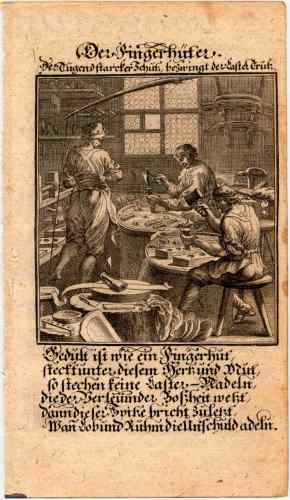 |
(Fig 1) Thimble makers in a 1698 book of
engravings by Johann Christoph Weigel
|
Weigel described the thimble makers in Nürnberg who were
classified with the other brass workers having been granted
independence from the coppersmiths in 1531. In his section on 'Fingerhuters'
(thimble makers), Weigel wrote:
"There are also double thimbles with the inner part being
completely smooth and gilded, and the outer part which fits
snugly over the inner part is made of silver and worked in
filigree which looks very attractive. They often decorate the
lower edge of the thimble by engraving garlands, foliage,
animals and the like, in which type of work the craftsmen of
Nürnberg remained the leaders because foreigners seldom engage
in it " (reference 2).
Weigel also described thimbles with 'star hats' which may refer
to the star dimpling found on the tops of the filigree thimbles
(Fig 2 bottom).
According to Weigel, Heinrich Leisen was the first thimble maker
to become a master around the end of the 15th century.
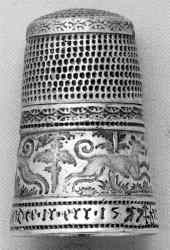
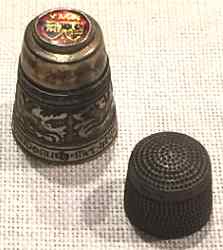 |
The earliest complete silver Nürnberg thimble
known to us
© Metropolitan Museum of Art, NY.
|
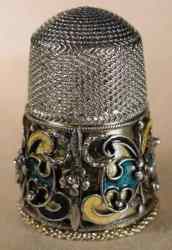
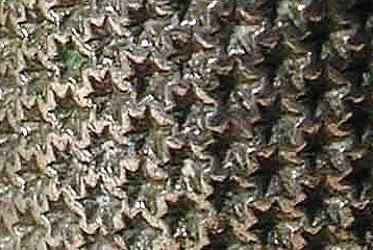 |
(Fig 2) Thimble with 'star hats'
|
Clearly Weigel's descriptions could have been applied to the
two thimbles shown in Fig 2. The top thimble is the earliest
complete silver Nürnberg thimble known to us and is held in the
Metropolitan Museum of Arts collection in New York. It has a
removable top under which is a glass, under painted (verre
eglomisee) with an alliance crest, it is dated 1577, has an
unknown makers mark (arrow) and is inscribed, around the rim, in
Plattdeutsch, 'Zier (?) leib unnde mich mer ist beidte ir err.
1577' (If you adorn your body and me, we are both honored).
Above the inscription are punched wild animals running in a wood.
The top of the thimble is hand dimpled and the lower portion is
gilded. There is only one other complete thimble of this kind
known to us. It is in the Kestner Museum in Hanover (Fig 3). It
has a hand dimpled top, a floral border and under the crystal in
the top are some flowers and the letters 'VGMN' (vergiss
mein nicht - forget me not). Above and below the floral rim is
the inscription 'der . erbarn . und . tugentsamen . frauen
verzierung hellena . Paerin . zu einem. s.n.iahr' 1595. (The
honorable and pure women's adornment Hellena Paerin to a s.n .year).
The bottom piece is gilded. There is an unknown maker's mark.
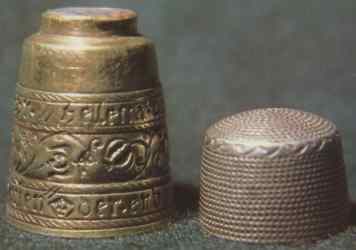 |
(Fig 3) Thimble in the Kestner Museum in Hanover
|
The earliest incomplete silver double thimble we know of is
in the Germanisches Nationalmuseum in Nürnberg and is dated 1573
(Fig 4). It is cast, with a punched decoration of figures and
circles and gilded. On the top is a crystal which is under
painted with a gold shield and three forget me not flowers, VMN'
(vergiss mein nicht - forget me not) and it is backed by a red
foil.
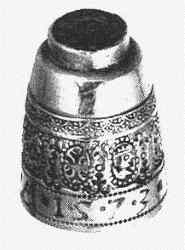 |
(Fig 4) The earliest incomplete silver double
thimble dated
1573 in the Germanisches Nationalmuseum in Nürnberg
|
We found a further incomplete example of this type of
thimble in the Kunstgewerbe Museum in Berlin (Fig 5). It too is
missing the top, the side is decorated in a way similar to the
brass thimbles of the time but below the decoration is an
inscription 'IVNKFRAW IVSTINA VON HERTEN' (Virgin Justina von
Herten). Under the crystal is a shield with flowers, the date
1606 and 'VGMN'.
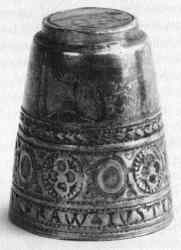 |
(Fig 5) Thimble in the Kunstgewerbe Museum in
Berlin
|
We know of a further similar thimble in a private collection
(Fig 6). It is also missing the top. It has a crystal (cracked
and damaged) engraved with three forget me not flowers, in the
form of a seal, over a coat of arms with three forget me not
flowers, below 'VMN' and is backed by a red foil. The top is
dated 1580. It has a geometric border and a flat rim with 'was
. got . bescherdt . imer . werdt . ist 1579'. (what God
gives is always valuable).
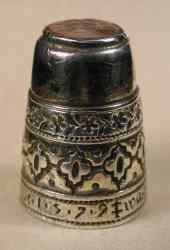
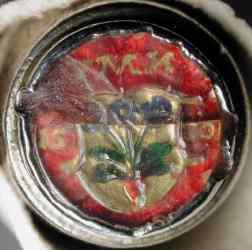
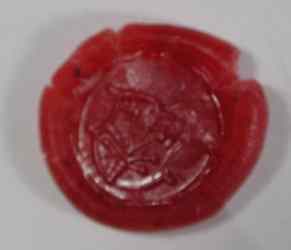 |
(Fig 6) Thimble dated 1580 in a private
collection
|
Dr Albert Figdor had a further four of these double Nürnberg
silver thimbles in his collection (Fig 7) but we have no idea
where they are now - they may have been auctioned although we
did not find them in the auction catalogue for the goldsmith's
items in his collection, or they could be in a museum somewhere.
Three of the four double thimbles had 'mottos' around the rim -
'Bin ich euch feint, so strew ich heint 1580' (no translation),
'Herzlich Liebe scheid sich nie 1582' (true love will never
part) and 'Allein mein oder las gar sein' (be mine alone or let
it be). Only one was complete.
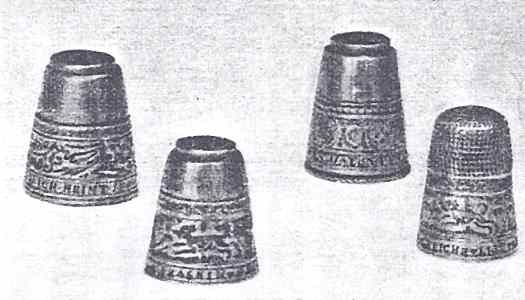 |
(Fig 7) Thimbles formerly in the collection of
Dr Albert Figdor
|
Interestingly we have found two brass thimbles of this type.
One is in the Kunstgewerbe Museum in Berlin (Fig 8) and the
other is in a private collection but it is missing the top (Fig
9). The former has a less intricate decoration than the silver
thimbles of the same type and comprises a series of oval wheels.
The top is hand dimpled. It is inscribed 'Glick und Liebe stielt
mir kein dieb 1599" (happiness and affection no thief can steal
from me).
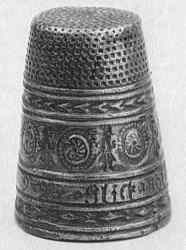 |
(Fig 8) Brass thimble in the Kunstgewerbe Museum
in Berlin
|
The thimble in the private collection has a very faded picture but an engraved 'E' can still be seen on top of the crystal. There is an unknown maker's mark.
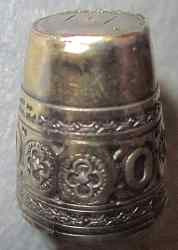
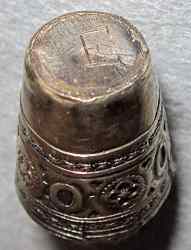 |
(Fig 9) Brass thimble in a private collection
|
It is thought that this thimble may predate the silver
thimbles, it is undated and the design is simpler than that on
the silver thimbles and resembles closely designs found on other
deep drawn brass thimbles. There is an unknown maker's mark.
By the end of the 16th century silver thimbles were regarded as
fashion pieces, keepsakes with mottos, and were most common
according to Rohde because they were more carefully kept than
other thimbles (reference 3). They were very expensive.
Below the caps was more evidence that they were gifts between
lovers. In all Nürnberg double silver thimbles there was a
crystal or glass, on the top of the lower part, which was often
cut to form a seal, below which was a colored foil, often red or
silver, a crest or two and 'VMN' or 'VGMN'. Sometimes there was
a date. Rhode (reference 3) thinks that it is unlikely
that the double thimbles were made by the thimblemakers in
Nürnberg but rather by the goldsmiths although he adds that the
caps may have been made by the thimblemakers. All of the
techniques necessary for the production of these thimbles were
practiced by goldsmiths - casting, gilding, enameling, engraving,
and soldering.
The second thimble described by Weigel (Fig 2 right, Fig 11) was
probably made a little later than the ones described above. It
has a mechanically indented top which reveals a pair of under
painted conjoined crests, one with the letters IHS (Jesus), and
the letters 'VGMN' which is protected by a crystal cover and
backed by red foil. The lower portion is 'gilded', has an 'H'
punch mark in a parallelogram slanting to the left and is
enclosed within an enameled, filigree, removable sleeve. The
re-stamp mark was used in Graz between 1806 and 1807 for small
gold items to signify the payment of a special tax. The
significance of the presence of this mark is not really known.
Clearly the thimble was made before 1807, but was it then made
around this time in Austria and therefore not a Nürnberg thimble,
or was it in a collection in Austria, made much earlier in
Nürnberg, and then had the tax paid later? The double Nürnberg
silver thimbles had gilded silver bases but this base was
assayed as gold, did the assayers make a mistake with the
gilding or is the base really gold? We think that it is most
likely that the thimble was made in Nürnberg and that there was
a mistake with the assay. It seems to be highly improbable that
a lone goldsmith in Austria would have the machinery for star
dimpling the top cap or the skills necessary for the under
painting of the top crystal.
Four complete thimbles of this type are known to us - all of the
other known examples are either missing a top or the filigree
band. One of these thimbles was illustrated in an edition of
Connaissance des Arts in 1956 (Fig 10). 'Les trois cents dés
du Baron Seillière' (reference 4) described many of the rare
thimbles collected by Baron Seillière and the Baron speculates
that possibly poison or perfume may have been kept under the
removable cap in the late 17th century. Many of the Baron's
thimbles were auctioned in Geneva in 1975.
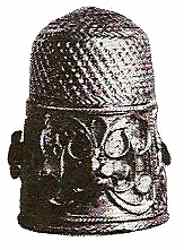 |
(Fig 10) Thimble formerly in the collection of
Baron Seillière
|
A second thimble is illustrated by Dreesmann in her book
(reference 5). She describes having purchased the thimble
from a dealer in London who had obtained it from an estate in
Vienna thus explaining the Austrian tax mark. Dreesmann further
describes finding that she could remove the top of her thimble
and finding 'a lovely plain gilt thimble with the maker's
initial, the top a beautiful miniature painting of two joined
coats of arms under glass' (Fig 11).
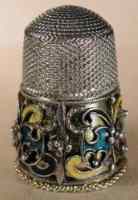
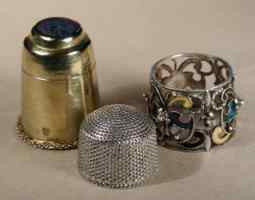 |
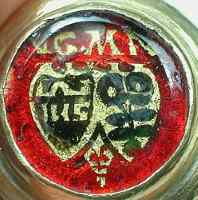
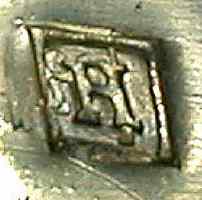 |
(Fig 11) Thimble illustrated in Dreesmann book
|
As well as this filigree thimble, two other similar complete
thimbles are known. One is in the Victoria and Albert Museum in
London (Fig 12). It was accessioned in 1923 as German 17th
century, the top may have been replaced prior to accession and
also the enamel on the filigree sleeve may have been repaired.
The under painted (reverse painted) picture may be a crest or
coat of arms with three rings of gold leaf applied to the
undersurface of the glass. The glass is damaged. There is no
maker's mark. In 1998 it was reassessed for a new silver display
and described as 'Vienna, second half of the 19th century'. We
believe the original description to have been the correct one.
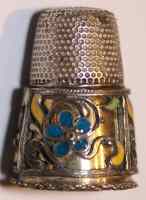
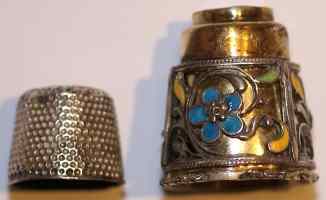
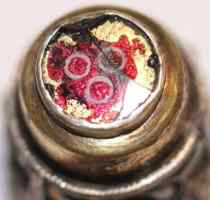 |
(Fig 12) Thimble in the Victoria and Albert
Museum in London
© Victoria and Albert Museum, London
|
The other thimble was auctioned by Christie's in 1998 (Fig
13 left) - 'a silver gilt thimble, with plain body and
applied rope-work rim, the tip with applied glazed compartment,
with an outer detachable part enameled scrollwork filigree
sleeve, the tip with lift off cover, Central European, late
sixteenth century' (reference 3). A similar, but topless,
filigree thimble was auctioned by Christie's in 1997 (Fig 13
right) - 'a silver gilt thimble, with plain body and chased
rim, the tip inset with a glazed enameled study of a couple,
with an outer detachable part-enameled scrollwork filigree
sleeve, cap deficient, Central European, late sixteenth century'
(reference 3).
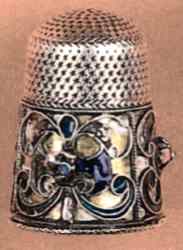
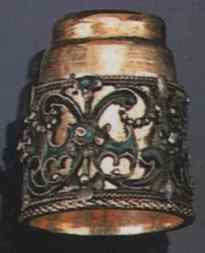 |
(Fig 13) Thimble auctioned by Christie's in 1998
- © Christie's
|
Five more of these thimbles, without filigree sleeves, are
known to be in private collections.
Nothing is known about one of these thimbles. The second one, is
missing the filigree sleeve, the top is machine dimpled and the
picture is no longer clearly visible (Fig 14). The third thimble
is very similar but there are two faded portraits to be seen
under the crystal (Fig 15). The fourth thimble has a tiny
portrait of a young woman protected by the crystal. The fifth
thimble (Fig 16) was in the collection of Dr Albert Figdor. It,
in contrast to all the other known thimbles of this type, had an
inscription above the filigree sleeve - 'Qui de coer aime, de
bon coer donne' (He who loves gives willingly) and 'E.I.'. On
the top of the thimble under the glass was a coat of arms with a
fleur de lys, half black and half gold, stamped with a helmet.
The cap was missing. The whereabouts of this thimble now is
unknown.
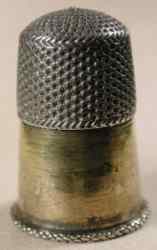
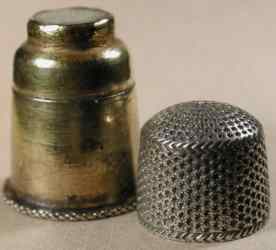
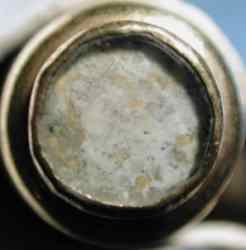 |
(Fig 14) Thimble in private collection missing
the filigree sleeve
|
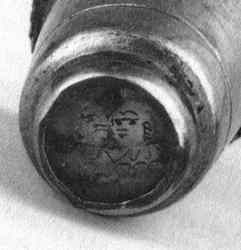 |
(Fig 15) Thimble showing two
faded portraits under the crystal
|
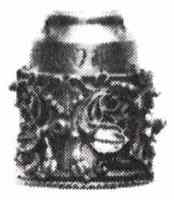 |
(Fig 16) Thimble in the
collection of Dr Albert Figdor
|
What is the evidence for the manufacture of the thimbles in
Nürnberg? Firstly, Nürnberg was the only city in Europe, at the
time, with craftsmen able to make such items. Thimble
manufacturing in Nürnberg was protected and neither masters nor
journeymen were allowed to leave the city. Thimble production
outside of Nürnberg really was only established in the 18th
century so these silver thimbles could not realistically have
been made anywhere else. Secondly, a gradual evolution in form
and construction of the Nürnberg thimble is easily seen from the
crude cast bronze thimble to the deep drawn, tall brass thimble,
to tall brass thimbles with a detachable top which were then
made in silver and finally given an enameled filigree sleeve (Fig
17).
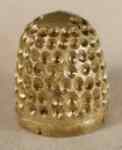
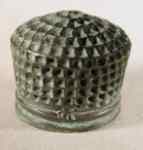
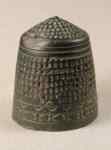
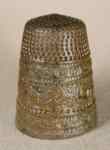 |
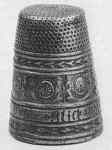
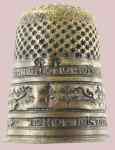
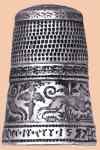
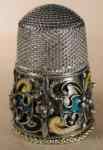 |
(Fig 17) Evolution in form and construction of
the Nürnberg thimbles
© Trustees of the British Museum, Portable
Antiquities Scheme (sixth from left)
|
Similar tall decorated thimbles may be seen on the bronze
epitaphs of some of the Nürnberg thimble maker's graves (reference
8) (Fig 18).
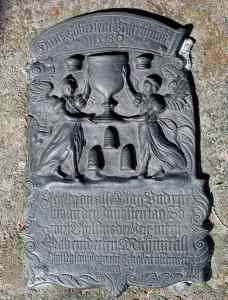
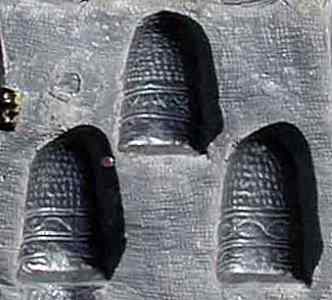 |
(Fig 18) Thimbles on Nürnberg thimble maker's
grave
|
The form of the tall silver thimbles is very similar to the
form of a gilded silver goblet known to have been made in
Nürnberg in 1586 by Elias Lenker (Fig 19). It was made for the
Tailors Guild of Nürnberg, is in the form of a thimble and has a
detachable base. This would seem to suggest that the style is
one that was common in Nürnberg at the time.
 |
(Fig 19) Silver goblet known to have been
made in Nürnberg in 1586 by Elias Lenker
|
How are the thimbles dated? Most of the thimbles, with the
exception of the filigree thimbles have dates either on the band
or on their tops (Fig 20).
 |
(Fig 20) Date on a thimble
|
The filigree thimbles are so similar to the dated thimbles
that they form a natural progression and it seems to be most
unlikely that there would have been a long gap in time between
the two types. The filigree thimbles seem to have machine
dimpled tops, a technique which was available at the end of the
16th c in Nürnberg. Although not allowed to be used by thimble
makers at the time in order not to give unfair advantage to the
richer thimble makers who could afford the machinery, it was
possibly used by goldsmiths.
Why are these thimbles so rare? Not many were made, they were
probably too expensive for most people, they may be 'lost' in
museum collections, rich houses, and in unknown private
collections (medieval collectors, silver collectors, thimble
collectors, seal collectors). They were most likely 'made to
order'.
Despite the many accounts of the early Nürnberg thimble makers
that have appeared over the years which, incidentally, are all
based on Weigel (reference 9, 10, 11, 12, 4) little seems
to have been added to our knowledge of the Nürnberg
thimblemakers or their work with the exception of Rhode (reference
3).
The double silver Nürnberg thimbles are not written about now at
all, but a filigree sleeved thimble was described, probably by
Mary Morris writing in the 'Girls Own Paper', in 1886-87(reference
13). She wrote 'The thimble is silver-gilt, covered with
open work scrolls, filled in with enamel. It belongs to the 18th
century'. A further description of a double thimble appeared
in the 'Sydney Mail' of 5th February 1887 (reference
14) . 'It was wrought in gold or silver, and a scene from
mythology was with minute accuracy engraved upon it. The rounded
top was made separately, a Cupid or other deity forming the
centre, round which was the inscription, in French and Latin, "'Force
d'Amor, Vis Amoris,'" was delicately wrought. Sometimes the top
of the thimble (thumb-bell) was ornamented with a kind of hollow
lid, filled with balsam or other perfume and only the most
primitive thimbles were open at the top like thimbles used by
tailors at the present time'. This report was attributed to
the 'Pall Mall Gazette '. It seems probable that these
writings, too, were based on Weigel.
What was the fate of these thimbles? In the late 16th and early
17th century, thimble making in Nürnberg was at a zenith and
these capped or double thimbles probably represent the highest
level of craftsmanship and metalworking skills, in relation to
thimble making, ever to be demonstrated in Nürnberg. As time
passed other towns, especially those in Holland, began to
develop their thimble making skills. By the middle of the 18th
century mechanized thimble production became a reality in
Holland and thimble making in Nürnberg began to decline.
Acknowledgement
We would like to thank Mr. Richard Edgcumbe, at the Victoria
and Albert Museum for his help in supplying information and the
pictures of the sleeved thimble in the museum's collection. We
also thank Dr.Wolfram Koeppe, Marina Kellen French Curator,
Department of European Sculpture and Decorative Arts, the
Metropolitan Museum of Art who was kind enough to provide
information and a picture of the thimble in the MMA's collection.
We also thank Carolyn Meacham for permission to use her images
in Fig 11 (bottom two) and Wolf-Dieter Scholz for helping with
the old documents and correcting the errors in the text.
References
1. Abbildung Der Gemein-Nützlichen Haupt-Stände Von denen
Regenten Und ihren So in Friedens- als Kriegs-Zeiten
zugeordneten Bedienten an, biß auf alle Künstler Und Handwercker.
Regenspurg 1698, Online- http://polona.pl/item/5308244/287/
2. Weigel C. Abbildung der Gemein-Nützlichen Haupt-Stände.
Regensburg, 1698. cited by Holmes EF. A history of thimbles.
London: Cornwall Books, 1985.
3. Rhode N. Von Fingerhut und seiner Vergangenheit. Die
Uhrmacherkunst, 1925; 1: 19.
4. Guth P. Les Trois Cents Dés du Baron Seillière.
Connaissance des Arts, March 1956, 44. cited by Blakeslee
Black A. Of Meissen Thimbles. Thimble Collectors
International, 2000.
5. Dreesmann C. A thimble full.... Utrecht/Netherlands:
Cambium, 1983; pp.70.
6. Christie's. Thimbles and Needlework Accessories. Lot 29.
9.12.1998.
7. Christie's. Thimbles and Needlework Accessories. Lot 153.
16.12.1997.
8. Isbister M, Isbister W. Die Fingerhut-Gräber in Nürnberg.
Rund um den Fingerhut, 2013: 56: 4.
9. P Abraham à S. Clara. Etwas für Alle. Würzburg: MF Hertz,
1711.
10. Krünitz JG. Oekonomisch-technologische Encyklopädie, oder
allgemeines System der Staats- Stadt- Haus- und Landwirthschaft,
wie auch der Erdbeschreibung, Kunst- und Naturgeschichte.
Berlin: J Pauli, 1773-1858.
11. Wagner M. Handwerk um 1700. Holländische und deutsche
Kupferstiche mit Beschreibungen von Christoph Weigel und
Betrachtungen von Abraham a Sancta Clara. Hürtgenwald: Guido
Pressler Verlag, 1985.
12. Rapp A. Fingerhut, Reallexikon zur Deutschen
Kunstgeschicate, Band VLLL, München: Beck, 1987.
13. Morris M. The Thimble and Thimble-makers. The Girls Own
Paper, 1887; 390: June 18.
14. Pall Mall Gazette*. Thimbles Old and New. The Sydney Mail,
1887 (Feb 5):XLIII (1387): 289.
(* "Thumb-Bells" ancient and modern. Pall Mall Gazette,
1886 (Nov 21); 13.) Makers' marks
It is now generally impossible to attribute a maker with a
mark because on the 2nd of January, 1945, 514 Lancaster bombers
destroyed the 'castle, the Rathaus, almost all the churches
and about 2000 preserved medieval houses' in what was
described as 'a near-perfect example of area bombing' at
the time. Included in the devastation were many of the city's
old documents including all the records of individual Nürnberg
thimble maker's marks.
Reproduction authorized by
Magdalena and William Isbister, Moosbach, Germany
Researched and published in 2014
Copyright©2014. All Rights Reserved
|
|
|

